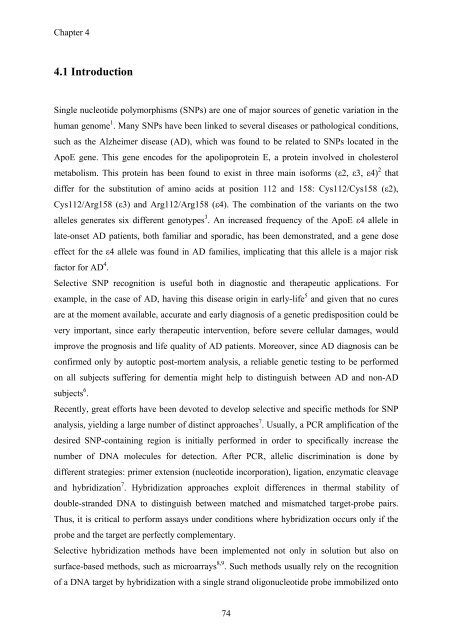View - DSpace UniPR
View - DSpace UniPR
View - DSpace UniPR
Create successful ePaper yourself
Turn your PDF publications into a flip-book with our unique Google optimized e-Paper software.
Chapter 4<br />
4.1 Introduction<br />
Single nucleotide polymorphisms (SNPs) are one of major sources of genetic variation in the<br />
human genome 1 . Many SNPs have been linked to several diseases or pathological conditions,<br />
such as the Alzheimer disease (AD), which was found to be related to SNPs located in the<br />
ApoE gene. This gene encodes for the apolipoprotein E, a protein involved in cholesterol<br />
metabolism. This protein has been found to exist in three main isoforms (ε2, ε3, ε4) 2 that<br />
differ for the substitution of amino acids at position 112 and 158: Cys112/Cys158 (ε2),<br />
Cys112/Arg158 (ε3) and Arg112/Arg158 (ε4). The combination of the variants on the two<br />
alleles generates six different genotypes 3 . An increased frequency of the ApoE ε4 allele in<br />
late-onset AD patients, both familiar and sporadic, has been demonstrated, and a gene dose<br />
effect for the ε4 allele was found in AD families, implicating that this allele is a major risk<br />
factor for AD 4 .<br />
Selective SNP recognition is useful both in diagnostic and therapeutic applications. For<br />
example, in the case of AD, having this disease origin in early-life 5 and given that no cures<br />
are at the moment available, accurate and early diagnosis of a genetic predisposition could be<br />
very important, since early therapeutic intervention, before severe cellular damages, would<br />
improve the prognosis and life quality of AD patients. Moreover, since AD diagnosis can be<br />
confirmed only by autoptic post-mortem analysis, a reliable genetic testing to be performed<br />
on all subjects suffering for dementia might help to distinguish between AD and non-AD<br />
subjects 6 .<br />
Recently, great efforts have been devoted to develop selective and specific methods for SNP<br />
analysis, yielding a large number of distinct approaches 7 . Usually, a PCR amplification of the<br />
desired SNP-containing region is initially performed in order to specifically increase the<br />
number of DNA molecules for detection. After PCR, allelic discrimination is done by<br />
different strategies: primer extension (nucleotide incorporation), ligation, enzymatic cleavage<br />
and hybridization 7 . Hybridization approaches exploit differences in thermal stability of<br />
double-stranded DNA to distinguish between matched and mismatched target-probe pairs.<br />
Thus, it is critical to perform assays under conditions where hybridization occurs only if the<br />
probe and the target are perfectly complementary.<br />
Selective hybridization methods have been implemented not only in solution but also on<br />
surface-based methods, such as microarrays 8,9 . Such methods usually rely on the recognition<br />
of a DNA target by hybridization with a single strand oligonucleotide probe immobilized onto<br />
74
















